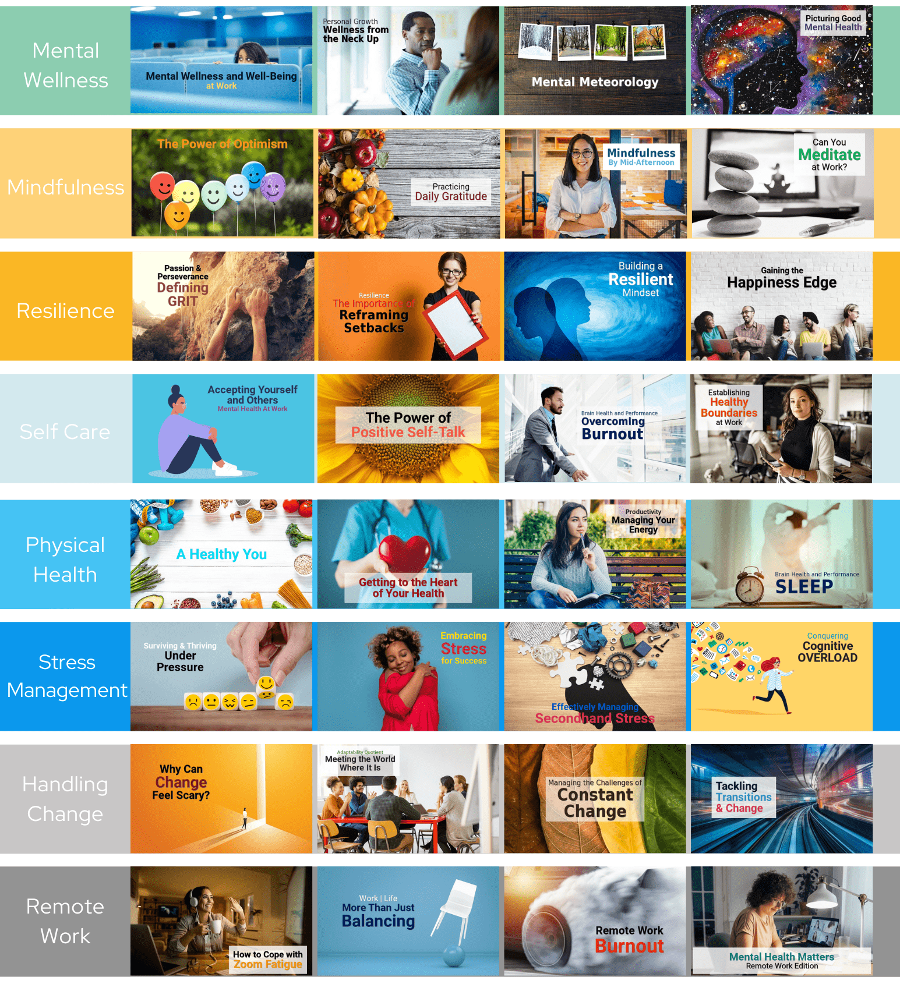Understanding Mental Health
It starts in your head: creativity, ingenuity, drive, and engagement, all those things that make for thriving teams and businesses with fruitful presents and bright futures. But the counterparts—stress, self-doubt, depression, anxiety, and feelings of isolation—are there, too. For leaders, this means that a focus on mental health and employee wellbeing isn’t just beneficial, it’s essential.
More than a year of drastic changes and societal reckonings has had an intense impact on employees worldwide. But while we’ve been asked to keep up, do more, and adjust at a mind-spinning pace, we can’t let our mental health fall by the wayside. And we don’t have to.
With positivity, solid growth and change management strategies, and a proactive approach to maintaining good mental health throughout typical and challenging times, we can create workplaces where people and possibility flourish. To start, let’s consider some foundational terms.
Mental Health is defined by the World Health Organization as a state of well-being in which an individual realizes their own abilities, can cope with the normal stresses of life and is capable of being a contributing member of their community. Mental health is determined by a range of socioeconomic, environmental, and biological factors.
46% OF WORKERS SURVEYED REPORT SUFFERING FROM MENTAL HEALTH ISSUES
Well-being is marked by positive feelings and an ability to function well, and it comprises an individual’s experience of their life. Well-being can be both objective and subjective. Simplified, well-being is the state of being comfortable, healthy, and happy.
A mental illness is a condition that affects a person’s thinking, feeling, and behavior or mood. Such conditions can impact day-to-day living and the ability to relate to others.
With depression as the leading cause of disability worldwide and a global crisis threatening to cost businesses as much as $16 trillion by 2030, mental health and well-being in the workplace are too significant to ignore.
A Different Sort of Epidemic
Though mental health and well-being have always been important, with the COVID-19 pandemic, increased social unrest, and the resulting rise in changeability and feelings of isolation, issues concerning mental health have taken center stage.
On their own, concerns about stability increase anxiety and stress. But during the past year, for many of us, that fear has been compounded by personal and professional complications.
From health concerns to suddenly working from home to child- and elder-care complexities to the loss of former outlets and time with loved ones, we’ve all been stretched a bit thin. In fact, team members across all levels have reported a decline in wellbeing, with 44 percent of individual contributors, 40 percent of managers, and 41 percent of C-level leaders seeing diminished mental health.
As leaders, we need to watch for the signs of suffering mental health and well-being in ourselves and our team members. A few signs of which include increased anger and irritability, frequent physical complaints, persistent sadness, escalating anxiety, recklessness, and changes in behavior or typical levels of productivity.

Impacts of an Unbalanced Workplace on Mental Health
It may be tempting to write off shifts in your or your teams’ moods as temporary slumps. We all need a vacation from time to time! But well-being and mental health go beyond the occasional string of bad days. And because we spend an average of 50 percent of our time either at work or on work-related tasks—often more for those of us now working from home—the impact of work on our mental health is large
Among the most significant professional stressors for employees are their workload, a perceived lack of recognition or impact, issues of inequality and exclusion, and conflicting work- and home-life demands. Work environments also play a role, with 37 percent reporting that theirs contributed to a decline in mental health.
Unfortunately, many of these issues have been exacerbated by COVID19 and the resulting disruptions in our norms and routines. And as employees are negatively affected, so too are the companies they work for. Impaired well-being leads to direct costs for businesses, including increases in healthcare expenditures and absenteeism and higher turnover rates. There are indirect tolls as well, such as reduced employee engagement, poor morale, substandard performance, and losses in productivity that cost the global economy as much as $1 trillion each year.
With the workplace playing such a pivotal role in mental health, the good news is it can also be a source of support
According to one study, mental health conditions accounted for over 60% of all reasons for absenteeism.
Improving Well-Being and Mental Health in the Workplace
There was a time, not long ago, when the workplace response to mental health and well-being issues was a shrug and a suggestion to keep a stiff upper lip. But those times, to the benefit of all of us, are gone. Instead, where we once had a de-facto “don’t ask, don’t tell” approach, we’re shifting now to “do ask, do tell, let’s talk.” And with that shift to a proactive, engaged, and open-minded attitude, leaders can help not only themselves but their teams—and their bottom lines—be as productive and prosperous as possible. All it takes is intention, information, a plan, and some follow-through.
Mind the Soft Skills
We all know the importance of tangible, hard skills because they’re what help us get the job done. But soft skills—empathy, resilience, emotional intelligence, and more—are what help us lead and work together as a cohesive and productive team. Strengthening these skills within your management and leadership levels should be your first step toward creating a healthy mental and emotional work environment.
The truth is people want to feel seen, heard, and valued. They want their feelings validated and their needs to be acknowledged. They want to know that their leaders and the company they work for care.
Create an Action Plan
Caring is important but without action to back it up, your concerns and those of your team will never truly resolve. So, get started on the right path by creating an organization-wide action plan. Here’s how:
- Consider your employees’ well-being baseline. Being an effective leader means paying attention to each of your team members. Don’t overwhelm yourself, but do your best to take note when attitudes, behaviors, and outputs change. These will often be the first signs of someone needing help.
- Communicate clear support for mental health concerns with concrete avenues for those needing help. From easily accessible information about support services to company-driven health and wellness initiatives, offer actionable avenues for getting help and staying healthy. Weave mental health and well-being topics into your ongoing learning and development content. This not only signals to your people that their leaders are investing in their well-being but also gives them the permission and tools to invest in it themselves.
- Model successful well-being and mental health behaviors, including a positive work-life balance and participation in wellness programs. This doesn’t mean you need to be perfect or pretend that you never have off days. Instead, it means leading by example when it comes to self-care, awareness, and open communication. Discussions of mental health and well-being shouldn’t be taboo, and if you lead the way with openness and honesty, your employees will follow suit.
The 'Me' in Team
Just like putting on your oxygen mask before helping others on a plane, you can’t ask yourself to improve your team’s well-being without tending to your own mental health first.
Begin by taking measure of your own well-being. If you’re feeling stressed, ask yourself if there's room for improvement in the following areas:
Work-Life Balance. If you’re struggling to “switch off” at the end of the day, try adding end-of-day rituals to your routine to reinforce the line between work and home.
Exercise and Healthy Eating. The mind and body aren’t separate, and just as poor mental health can take a toll on your physical health, good physical health improves your well-being. Cutting unhealthy snacks and adding a bit of exercise to your routine can give you a kick start toward wellness.
Mindfulness and Meditation. Meditating for just ten minutes each day can improve mindfulness and reduce stress. In turn, mindfulness can help you expand your perspective, which helps you better manage change and day-to-day hurdles.
Taking Breaks. Especially when you’re feeling overwhelmed or behind, taking a break can seem impossible. But the truth is, we’re not designed to work all the time! And relaxation is a necessity. If you don’t take the time to slow down and step away from time to time, you may be courting burnout.
/change-embracer_LI.jpg?width=660&name=change-embracer_LI.jpg)
Leading the Way
Once you’ve added a focus on your own well-being, you’ll be ready to support and facilitate your team in doing the same. Here are some tips to get started:
- Communicate. This one is a wide umbrella. From a willingness to be vulnerable, open, and communicate your own approaches to mental health to inviting team members to share their needs with you, communication is a cornerstone of a healthy workplace. As a leader, make sure to communicate company policies, present yourself as an avenue for support, and keep your door open.
- Facilitate access to resources. Being a leader with a focus on employee well-being doesn’t mean being your team’s therapist. It also doesn’t mean compromising your own boundaries or crossing professional lines. Instead, use
your position to pay attention, be an active listener and steer your employees toward the help they need. - Empower learning and conversations around mental health and self-care. Give your people accessible, approachable learning content on the importance and benefits of taking care of one's mental health. Bite-sized microlearning lessons delivered in an ongoing pathway can offer consumable, actionable learning that sparks growth and dialogue around one topic at a time.
Reaping the Benefits
Happy people make good employees. Having a solid sense of well-being and a healthy approach to emotional and mental complexities strengthens our resilience and helps us overcome adversity. We’re able to better understand and communicate our emotions, adapt to uncertainty, build good relationships, cope with daily stresses, and ultimately engage with the world by living and working productively
If you are ready to engage your people on a journey to mental wellness and want to learn more about how Blue Ocean Brain can help, contact us or visit blueoceanbrain.com.





